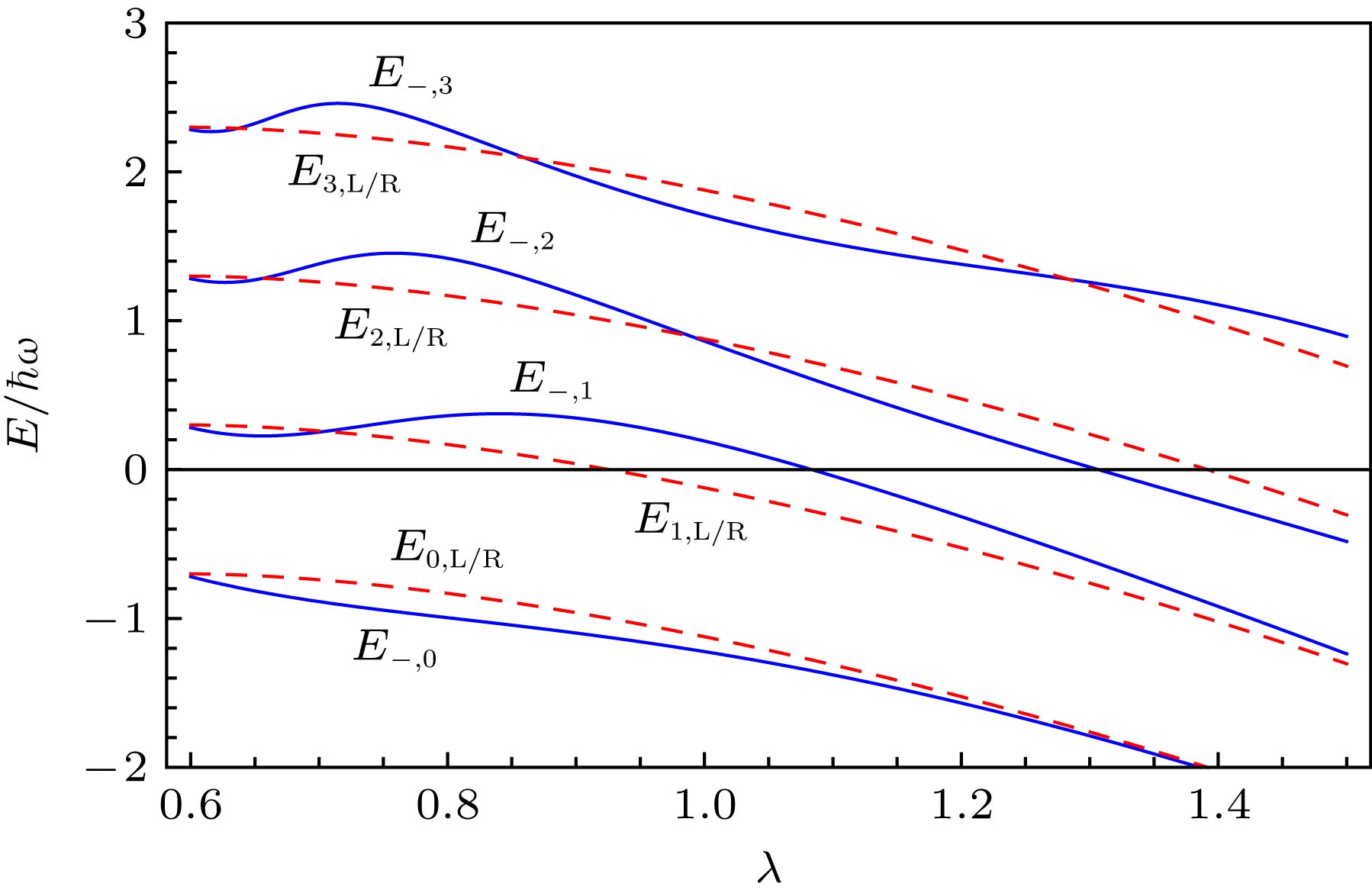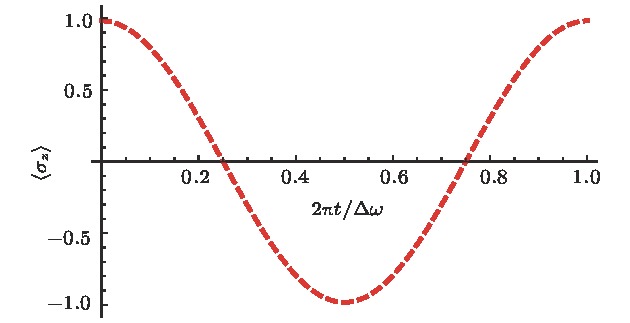-
量子光学中的Rabi模型描述了一个与量子谐振子耦合的两能级系统, 当耦合强度与振子频率相当时, 会产生丰富的物理现象. 本文研究了谐波势阱中具有拉曼诱导自旋轨道耦合的Bose气体, 通过将受限系统映射为Rabi模型, 引入量子光学中的平移Fock态利用变分方法求解了系统的本征能态和基态, 发现左右平移Fock态的奇宇称叠加态能量低于平移态的能量,并分别研究了粒子在动量和坐标空间的动力学Zitterbewegung振荡特性以及原子极化的动力学, 给出了一个直观清晰的物理图像, 与相关实验的结果定性一致. 本文的研究结果有助于进一步研究量子光学领域目前难以实现的深度强耦合参数区域的量子Rabi模型, 对冷原子物理的研究也有一些借鉴和启发.
-
关键词:
- Rabi模型 /
- 自旋轨道耦合 /
- Zitterbewegung振荡 /
- 平移Fock态 /
- 变分法
Rabi model is a popular model in quantum optics and describes a two-level system coupling to a quantum resonator. The fruitful physics appears when the coupling strength is comparable to the frequency of the resonator. We investigate the Bose gases of Raman induced spin-orbit coupling with an external harmonic trapping. Using the displacement Fock state in quantum optics we seek for an approximate ground state. We find the superposition state of left and right displaced oscillator state with odd parity has lower energy than the displaced state itself. Besides, we study the time evolution of both the momentum and the position of the system at single particle level to demonstrate the Zitterbewegung oscillating characteristics, which present an intuitive physical picture and are in qualitative agreement with the relevant experimental results. The results are useful to study the Rabi model in deep-strong coupling regime, the model that is difficult to realize in today’s experiment based on the high controllability property of laser, and these results are also instructive for the cold atom physics field.-
Keywords:
- Rabi model /
- spin-orbit coupling /
- Zitterbewegung oscillations /
- displacement Fock state /
- variational method
[1] Xiao D, Chang M C, Niu Q 2010 Rev. Mod. Phys. 82 1959
 Google Scholar
Google Scholar
[2] Hasan M Z, Kane C L 2010 Rev. Mod. Phys. 82 3045
 Google Scholar
Google Scholar
[3] Zutic I, Fabian J, Sarma S D 2004 Rev. Mod. Phys. 76 323
 Google Scholar
Google Scholar
[4] Lin Y J, Garcıa K J, Spielman I B 2011 Nature 471 8386
[5] Wang P, Yu Z Q, Fu Z, Miao J, Huang L, Chai S, Zhai H, Zhang J 2012 Phys. Rev. Lett. 109 095301
 Google Scholar
Google Scholar
[6] Cheuk L W, Sommer A T, Hadzibabic Z, Yefsah T, Bakr W S, Zwierlein M W 2012 Phys. Rev. Lett. 109 095302
 Google Scholar
Google Scholar
[7] Zhang J Y, Ji S C, Chen Z, Zhang L, Du Z D, Yan B, Pan G S, Zhao B, Deng Y J, Zhai H, Chen S, Pan J W 2012 Phys. Rev. Lett. 109 115301
 Google Scholar
Google Scholar
[8] Galitski V, Spielman I B 2013 Nature 494 4954
[9] Lin Y J, Compton R L, Garcia K J, Porto J V, Spielman I B 2009 Nature 462 628
 Google Scholar
Google Scholar
[10] Lin Y J, Compton R L, Perry A R, Phillips W D, Porto J V, Spielman I B 2009 Phys. Rev. Lett. 102 130401
 Google Scholar
Google Scholar
[11] Qu C, Hamner C, Gong M, Zhang C, Engels P 2013 Phys. Rev. A 88 021604
 Google Scholar
Google Scholar
[12] LeBlanc L J, Beeler M C, Jimenez-Garcia K, Perry A R, Sugawa S, Williams R A, Spielman I B 2013 New J. Phys. 15 073011
 Google Scholar
Google Scholar
[13] Wu C J, Mondragon-Shem I, Zhou X F 2011 Chin. Phys. Lett. 28 097102
 Google Scholar
Google Scholar
[14] Hu H, Ramachandhran B, Pu H, Liu X J 2012 Phys. Rev. Lett. 108 010402
 Google Scholar
Google Scholar
[15] Sinha S, Nath R, Santos L 2011 Phys. Rev. Lett. 107 270401
 Google Scholar
Google Scholar
[16] Ghosh S K, Vyasanakere J P, Shenoy V B, 2011 Phys. Rev. A 84 053629
 Google Scholar
Google Scholar
[17] Larson J, Anderson B M, Altland A 2013 Phys. Rev. A 87 013624
 Google Scholar
Google Scholar
[18] Rabi I I 1936 Phys. Rev. 49 324
 Google Scholar
Google Scholar
[19] Rabi I I 1937 Phys. Rev. 51 652
 Google Scholar
Google Scholar
[20] Braak D 2011 Phys. Rev. Lett. 107 100401
 Google Scholar
Google Scholar
[21] Chen Q H, Wang C, He S, Liu T, Wang K L 2012 Phys. Rev. A 86 023822
 Google Scholar
Google Scholar
[22] Solano E 2011 Physics 4 68
 Google Scholar
Google Scholar
[23] Gardas, Dajka J 2013 arXiv: 1301.5660[quant-ph]
[24] Wolf F A, Kollar M, Braak D 2012 Phys. Rev. A 85 053817
 Google Scholar
Google Scholar
[25] Walther H, Varcoe B, Englert B, Becker T 2006 Rep. Prog. Phys. 69 1325
 Google Scholar
Google Scholar
[26] Raimond J M, Brune M, Haroche S 2001 Rev. Mod. Phys. 73 565
 Google Scholar
Google Scholar
[27] Holstein T 1959 Ann. Phys. 8 325
 Google Scholar
Google Scholar
[28] Mabuchi H, Doherty A C 2002 Science 298 1372
 Google Scholar
Google Scholar
[29] Niemczyk T, Deppe F, Huebl H, Menzel E P, Hocke F, Schwarz M J, Garcia-Ripoll J J, Zueco D, Hümmer T, Solano E, Marx A, Gross R 2010 Nature Phys. 6 772
 Google Scholar
Google Scholar
[30] Forn-Diaz P, Lisenfeld J, Marcos D, Garcia-Ripoll J J, Solano E, Harmans C J P M, Mooij J E 2010 Phys. Rev. Lett. 105 237001
 Google Scholar
Google Scholar
[31] Fu Z, Wang P, Chai S, Huang L, Zhang J 2011 Phys. Rev. A 84 043609
 Google Scholar
Google Scholar
[32] Cahill K K, Glauber R J 1969 Phys. Rev. 177 1857
 Google Scholar
Google Scholar
[33] Graham R, Hohnerbach M 1984 Phys. B: Condens. Matter 57 233
 Google Scholar
Google Scholar
-
图 1 简并量子态
$\left| {{\psi _{N{\rm{,L}}\left( {\rm{R}} \right)}}} \right\rangle $ 能量${E_{N,{\rm{L/R}}}}$ 与左右平移奇宇称叠加态$\left| {{\psi _{ - ,N}}} \right\rangle $ 能量${E_{ - ,N}}$ 随SO耦合强度$\lambda $ 的变化 可见$N = 0$ 叠加态$\left| {{\psi _{ - ,0}}} \right\rangle $ 能量最低, 更接近基态; 而对于激发态$N \ne 0$ , 二者能量随参数变化出现交叉; 相关参数取值为$\varOmega \; = \;{\rm{1}}{\rm{.4}}\omega $ , 与文献[19]精确解的结果基本一致Fig. 1. The energies of degenerate quantum states
$\left| {{\psi _{N{\rm{,L}}\left( {\rm{R}} \right)}}} \right\rangle $ and the superposition state of odd parity$\left| {{\psi _{ - ,N}}} \right\rangle $ of left(right)-displaced number states varies as the spin-orbit coupling strength$\lambda $ . It is seen that for$N = 0$ , the superposition state has the lowest energy which is the best approximation for the ground state in our interest. And for the cases of$N \ne 0$ , the energies of the two quantum states have pitchforks.The relevant parameters is Ω=1.4 and the results are in agreement with those in Ref.[19].图 2 原子动量分布概率的粗粒动力学演化 (3D, 左侧; 2D, 右侧) 相关参数取值为
$\varOmega \; = \;{\rm{3}}\omega $ ,$ \lambda \; = \;{\rm{2}}\omega $ , 初态为$\varPsi (t = 0) = {\psi _{0,{\rm L}}}$ , 动量$ \tilde p = \sqrt {1/m\hbar \omega } p $ Fig. 2. The coarse dynamics evulution of momentum distribution of single particle (left for 3D; right for 2D) with
$\varOmega \; = \;{\rm{3}}\omega $ and$ \lambda \; = \;{\rm{2}}\omega $ . The initial state is set as$\varPsi (t = 0) = {\psi _{0,{\rm{L}}}}$ . Momentum$\tilde p$ is defined by$ \tilde p = \sqrt {1/m\hbar \omega } p $ .图 3 原子空间位置分布概率的粗粒动力学演化(3D, 左侧; 2D, 右侧) 相关参数取值及初态同图2, 位置
$ \tilde q = \sqrt {m\omega /\hbar } q $ Fig. 3. The coarse dynamics evolution of position distribution of single particle (left for 3D; right for 2D) with the same parameters and the initial state in Fig. 2 and
$ \tilde q = \sqrt {m\omega /\hbar } q $ .图 4 原子极化
$\left\langle {{\sigma _z}} \right\rangle $ 随时间演化初态为$\varPsi \left( {t = 0} \right) = {\psi _{0,{\rm{L}}}}$ , 参数取值为$\varOmega \; = \;{\rm{3}}\omega $ 和$ \lambda \; = \;{\rm{2}}\omega $ , 时间以因子${{2{\text{π}}}/{\Delta \omega }}$ 标度Fig. 4. Time evolution of
$\left\langle {{\sigma _z}} \right\rangle $ with the initial state being$\varPsi \left( {t = 0} \right) = {\psi _{0,{\rm{L}}}}$ and the parameters$\varOmega \; = \;{\rm{3}}\omega $ and$ \lambda \; = \;{\rm{2}}\omega $ . The time is scaled by the tunneling period$2{\text{π}}/\Delta\omega $ . -
[1] Xiao D, Chang M C, Niu Q 2010 Rev. Mod. Phys. 82 1959
 Google Scholar
Google Scholar
[2] Hasan M Z, Kane C L 2010 Rev. Mod. Phys. 82 3045
 Google Scholar
Google Scholar
[3] Zutic I, Fabian J, Sarma S D 2004 Rev. Mod. Phys. 76 323
 Google Scholar
Google Scholar
[4] Lin Y J, Garcıa K J, Spielman I B 2011 Nature 471 8386
[5] Wang P, Yu Z Q, Fu Z, Miao J, Huang L, Chai S, Zhai H, Zhang J 2012 Phys. Rev. Lett. 109 095301
 Google Scholar
Google Scholar
[6] Cheuk L W, Sommer A T, Hadzibabic Z, Yefsah T, Bakr W S, Zwierlein M W 2012 Phys. Rev. Lett. 109 095302
 Google Scholar
Google Scholar
[7] Zhang J Y, Ji S C, Chen Z, Zhang L, Du Z D, Yan B, Pan G S, Zhao B, Deng Y J, Zhai H, Chen S, Pan J W 2012 Phys. Rev. Lett. 109 115301
 Google Scholar
Google Scholar
[8] Galitski V, Spielman I B 2013 Nature 494 4954
[9] Lin Y J, Compton R L, Garcia K J, Porto J V, Spielman I B 2009 Nature 462 628
 Google Scholar
Google Scholar
[10] Lin Y J, Compton R L, Perry A R, Phillips W D, Porto J V, Spielman I B 2009 Phys. Rev. Lett. 102 130401
 Google Scholar
Google Scholar
[11] Qu C, Hamner C, Gong M, Zhang C, Engels P 2013 Phys. Rev. A 88 021604
 Google Scholar
Google Scholar
[12] LeBlanc L J, Beeler M C, Jimenez-Garcia K, Perry A R, Sugawa S, Williams R A, Spielman I B 2013 New J. Phys. 15 073011
 Google Scholar
Google Scholar
[13] Wu C J, Mondragon-Shem I, Zhou X F 2011 Chin. Phys. Lett. 28 097102
 Google Scholar
Google Scholar
[14] Hu H, Ramachandhran B, Pu H, Liu X J 2012 Phys. Rev. Lett. 108 010402
 Google Scholar
Google Scholar
[15] Sinha S, Nath R, Santos L 2011 Phys. Rev. Lett. 107 270401
 Google Scholar
Google Scholar
[16] Ghosh S K, Vyasanakere J P, Shenoy V B, 2011 Phys. Rev. A 84 053629
 Google Scholar
Google Scholar
[17] Larson J, Anderson B M, Altland A 2013 Phys. Rev. A 87 013624
 Google Scholar
Google Scholar
[18] Rabi I I 1936 Phys. Rev. 49 324
 Google Scholar
Google Scholar
[19] Rabi I I 1937 Phys. Rev. 51 652
 Google Scholar
Google Scholar
[20] Braak D 2011 Phys. Rev. Lett. 107 100401
 Google Scholar
Google Scholar
[21] Chen Q H, Wang C, He S, Liu T, Wang K L 2012 Phys. Rev. A 86 023822
 Google Scholar
Google Scholar
[22] Solano E 2011 Physics 4 68
 Google Scholar
Google Scholar
[23] Gardas, Dajka J 2013 arXiv: 1301.5660[quant-ph]
[24] Wolf F A, Kollar M, Braak D 2012 Phys. Rev. A 85 053817
 Google Scholar
Google Scholar
[25] Walther H, Varcoe B, Englert B, Becker T 2006 Rep. Prog. Phys. 69 1325
 Google Scholar
Google Scholar
[26] Raimond J M, Brune M, Haroche S 2001 Rev. Mod. Phys. 73 565
 Google Scholar
Google Scholar
[27] Holstein T 1959 Ann. Phys. 8 325
 Google Scholar
Google Scholar
[28] Mabuchi H, Doherty A C 2002 Science 298 1372
 Google Scholar
Google Scholar
[29] Niemczyk T, Deppe F, Huebl H, Menzel E P, Hocke F, Schwarz M J, Garcia-Ripoll J J, Zueco D, Hümmer T, Solano E, Marx A, Gross R 2010 Nature Phys. 6 772
 Google Scholar
Google Scholar
[30] Forn-Diaz P, Lisenfeld J, Marcos D, Garcia-Ripoll J J, Solano E, Harmans C J P M, Mooij J E 2010 Phys. Rev. Lett. 105 237001
 Google Scholar
Google Scholar
[31] Fu Z, Wang P, Chai S, Huang L, Zhang J 2011 Phys. Rev. A 84 043609
 Google Scholar
Google Scholar
[32] Cahill K K, Glauber R J 1969 Phys. Rev. 177 1857
 Google Scholar
Google Scholar
[33] Graham R, Hohnerbach M 1984 Phys. B: Condens. Matter 57 233
 Google Scholar
Google Scholar
计量
- 文章访问数: 17505
- PDF下载量: 127
- 被引次数: 0




























 下载:
下载:

























